monitoring and evaluation of wells and methow hatchery programs .
monitoring and evaluation of wells and methow hatchery programs .
monitoring and evaluation of wells and methow hatchery programs .
You also want an ePaper? Increase the reach of your titles
YUMPU automatically turns print PDFs into web optimized ePapers that Google loves.
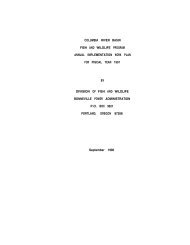
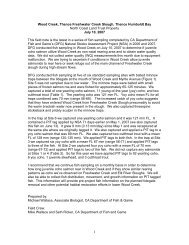
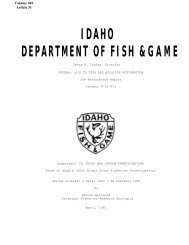
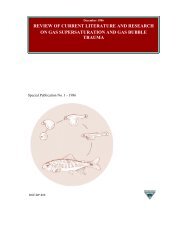
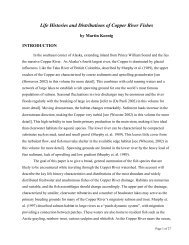
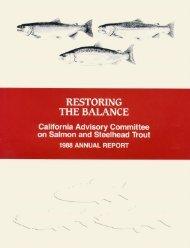
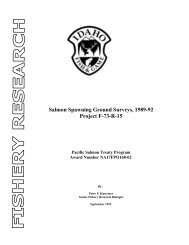
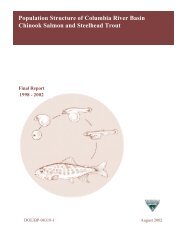
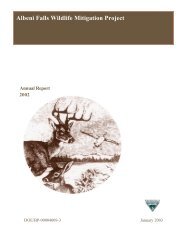
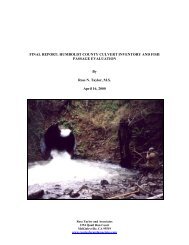
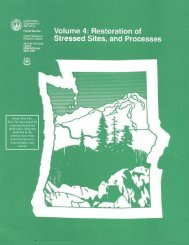
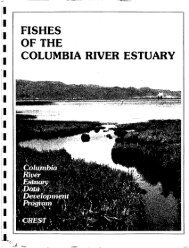
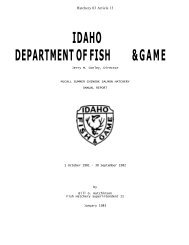
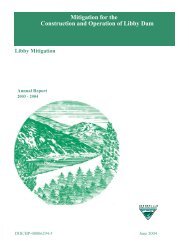
 IMPRINTING SALMON AND STEELHEAD TROUT FOR HOMING . " width="208" height="300" />
IMPRINTING SALMON AND STEELHEAD TROUT FOR HOMING . " width="208" height="300" />
MONITORING AND EVALUATION OF WELLS AND METHOW HATCHERY PROGRAMS IN 2010 Prepared for Douglas County Public Utility District and Wells Habitat Conservation Plan Hatchery Committee by Charlie Snow, Charles Frady, and Alex Repp Washington Department of Fish and Wildlife Supplementation Research Team Methow Field Office Twisp, WA Andrew Murdoch Washington Department of Fish and Wildlife Supplementation Research Team Wenatchee Field Office Wenatchee, WA and Maureen P. Small, Sarah Bell, and Cheryl Dean Washington Department of Fish and Wildlife Conservation Biology Unit, Molecular Genetics Laboratory Olympia, WA April 2011
- Page 2 and 3: Executive Summary Chapter 1: 2008 B
- Page 4 and 5: salmon spawning ground surveys in 2
- Page 6 and 7: Table of Contents Executive Summary
- Page 8 and 9: annual reports are based on activit
- Page 10 and 11: Figure 1. Map of Methow River basin
- Page 12 and 13: Introduction To be successful, supp
- Page 14 and 15: Run escapement estimates for Wells
- Page 16 and 17: collection facility in the Chewuch
- Page 18 and 19: Table 3. Mean fork length (cm; N; S
- Page 20 and 21: Table 7. Percentage of 2008 brood f
- Page 22 and 23: Size of Juvenile Fish Released Targ
- Page 24 and 25: Table 11. The expected and actual s
- Page 26 and 27: Mean ELISA values of spring Chinook
- Page 28 and 29: SRT 2009. Implementation of compreh
- Page 30 and 31: Permit 1196; (3) Methow spring Chin
- Page 32 and 33: Weekly estimates of natural-origin
- Page 34 and 35: Table 3. Assumptions and calculatio
- Page 36 and 37: Table 4. Adult steelhead collection
- Page 38 and 39: increase natural production and hav
- Page 40 and 41: Appendix B. Number of broodstock sp
- Page 42 and 43: Appendix B, continued. Number of Br
- Page 44 and 45: Appendix C, continued. Brood Sex Ag
- Page 46 and 47: Appendix C, continued. Male Female
- Page 48 and 49: Appendix C, continued. Brood Sex Ag
- Page 50 and 51: Appendix D, continued. Brood Age-3
- Page 52 and 53: Appendix E. Results of ELISA sampli
- Page 54 and 55: Appendix F. Hatchery life stage sur
- Page 56 and 57: Appendix G. Annual releases by prog
- Page 58 and 59: Appendix H, continued. Brood Progra
- Page 60 and 61: Appendix H, continued. Days Brood P
- Page 62 and 63: Appendix I. Mean fork length (mm),
- Page 64 and 65: Appendix I, continued. Brood Fork l
- Page 66 and 67: Objective 5: Determine if the stray
- Page 68 and 69: salmon in the Chewuch River were ac
- Page 70 and 71: spring Chinook salmon and from 63%
- Page 72 and 73: Table 4. Percent of total hatchery
- Page 74 and 75: Proportion of Wells summer Chinook
- Page 76 and 77: Table 7. Total adult return and num
- Page 78 and 79: Table 9. Total number of steelhead
- Page 80 and 81: References Hahn, P., Zeylmaker S. a
- Page 82 and 83: Incidental Impacts on steelhead The
- Page 84 and 85: Appendix B, continued. Brood Broods
- Page 86 and 87: Appendix C2. Proportion by return y
- Page 88 and 89: invasive method of producing specie
- Page 90 and 91: were counted, measured to the neare
- Page 92 and 93: Variance for daily emigration estim
- Page 94 and 95: Discharge m 3 /s Results Smolt Trap
- Page 96 and 97: Number of Chinook Discharge m 3 /s
- Page 98 and 99: Number of steelhead Discharge m 3 /
- Page 100 and 101: Number of Chinook Dishcharge m 3 /s
- Page 102 and 103: Table 4. Mean length at migration a
- Page 104 and 105: Table 6. Mark and recapture efficie
- Page 106 and 107: Summer Steelhead smolt trap We were
- Page 108 and 109: Table 13. Estimated emigrant-per-re
- Page 110 and 111: Table 15. Biological sampling condu
- Page 112 and 113: that the majority of the yearling C
- Page 114 and 115: References Cheng, Y., and M. Gallin
- Page 116 and 117: Appendix A1. Daily capture of wild
- Page 118 and 119: Appendix A2. Daily capture of wild
- Page 120 and 121: Appendix A3, continued. Date Captur
- Page 122 and 123: Appendix A4, continued. Date Captur
- Page 124 and 125: Appendix A5, continued. Date Captur
- Page 126 and 127: Appendix A6. Daily capture of wild
- Page 128 and 129: Appendix A7. Daily detection of wil
- Page 130 and 131: Appendix B1, continued. Tag file Sp
- Page 132 and 133: Appendix B3. Loss of PIT tags inser
- Page 134 and 135: Appendix B5. Loss of PIT tags inser
- Page 136 and 137: Appendix B6. Loss of PIT tags inser
- Page 138 and 139: Appendix B7. Loss of PIT tags inser
- Page 140 and 141: Appendix B8. Loss of PIT tags inser
- Page 142 and 143: Appendix B8, continued. Tag file Sp
- Page 144 and 145: 2004) with the Rannala and Mountain
- Page 146 and 147: References Belkhir, K., P. Borsa, L
- Page 148 and 149: Figure 2. Ancestry values for indiv
- Page 150 and 151: Table 1. List of samples used in th
- Page 152 and 153: Table 3. Juvenile assignment data f
- Page 154 and 155: 10DY01 47 10DY01 48 10DY01 49 10DY0
- Page 156 and 157: surveys and associated activities (
- Page 158 and 159: each subbasin based on information
- Page 160 and 161: Table 4. Chewuch River subbasin sur
- Page 162 and 163: In 2010, redd counts derived from e
- Page 164 and 165: Migration Timing and Spawner Compos
- Page 166 and 167: Table 7. Escapement and disposition
- Page 168 and 169: 110 105 Hatchery Wild 100 Julian da
- Page 170 and 171: Julian date 100 95 90 85 80 75 70 6
- Page 172 and 173: Table 10. Methow River mainstem ind
- Page 174 and 175: Table 11. Detection of PIT tags in
- Page 176 and 177: Figure 9. Spatial distribution of o
- Page 178 and 179: Figure 11. Spatial distribution of
- Page 180 and 181: Table 13. Lower Methow River mainst
- Page 182 and 183: Table 15. Chewuch River mainstem an
- Page 184 and 185: Wells Dam (N = 2,070). Expanded ret
- Page 186 and 187: Table 21. Expanded totals and stray
- Page 188 and 189: As PIT tag technology increases in
- Page 190 and 191: Appendix A. Summer steelhead run es
- Page 192 and 193: Appendix B2. Lower Methow River sub
- Page 194 and 195: Appendix B4. Chewuch River subbasin
- Page 196 and 197: similar to those of naturally produ
- Page 198 and 199: spring Chinook salmon based on body
- Page 200 and 201: Statistical Analyses For all compar
- Page 202 and 203: Julian date 180 175 170 165 160 155
- Page 204 and 205: Table 2. 2010 spring Chinook salmon
- Page 206 and 207: Table 4. 2010 spring Chinook salmon
- Page 208 and 209: Figure 4. Spatial distribution of s
- Page 210 and 211: Figure 6. Spatial distribution of s
- Page 212 and 213: Spawner Composition, Demographics,
- Page 214 and 215: Figure 10. Spatial distribution of
- Page 216 and 217: Age, origin, gender, and length wer
- Page 218 and 219: Natural Replacement Rate Natural re
- Page 220 and 221: Stray Rates within the Methow Basin
- Page 222 and 223: Stray Rates outside the Methow Basi
- Page 224 and 225: activities at local hatcheries. Dat
- Page 226 and 227: Appendix A. Natural Replacement Rat
- Page 228 and 229: Appendix C. Expanded coded wire tag
- Page 230 and 231: Appendix D. Estimated escapement fr
- Page 232 and 233: Appendix F. Estimated escapement fr
- Page 234 and 235: Appendix H. Estimated escapement fr
- Page 236 and 237: Appendix J. Estimated escapement fr
- Page 238 and 239: Appendix L. Estimated escapement fr
- Page 240: Appendix M, continued. Hatchery fis
















 IMPRINTING SALMON AND STEELHEAD TROUT FOR HOMING . " width="208" height="300" />
IMPRINTING SALMON AND STEELHEAD TROUT FOR HOMING . " width="208" height="300" />